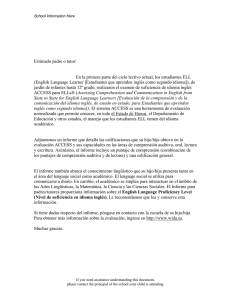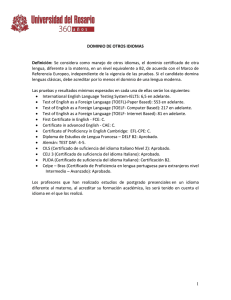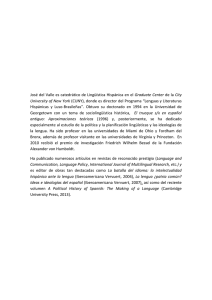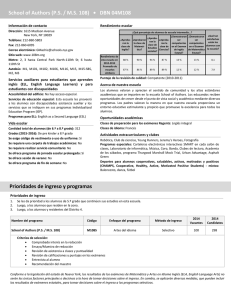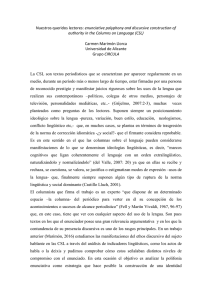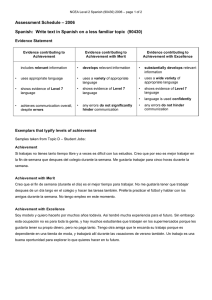Understanding the California English Language Development
Anuncio
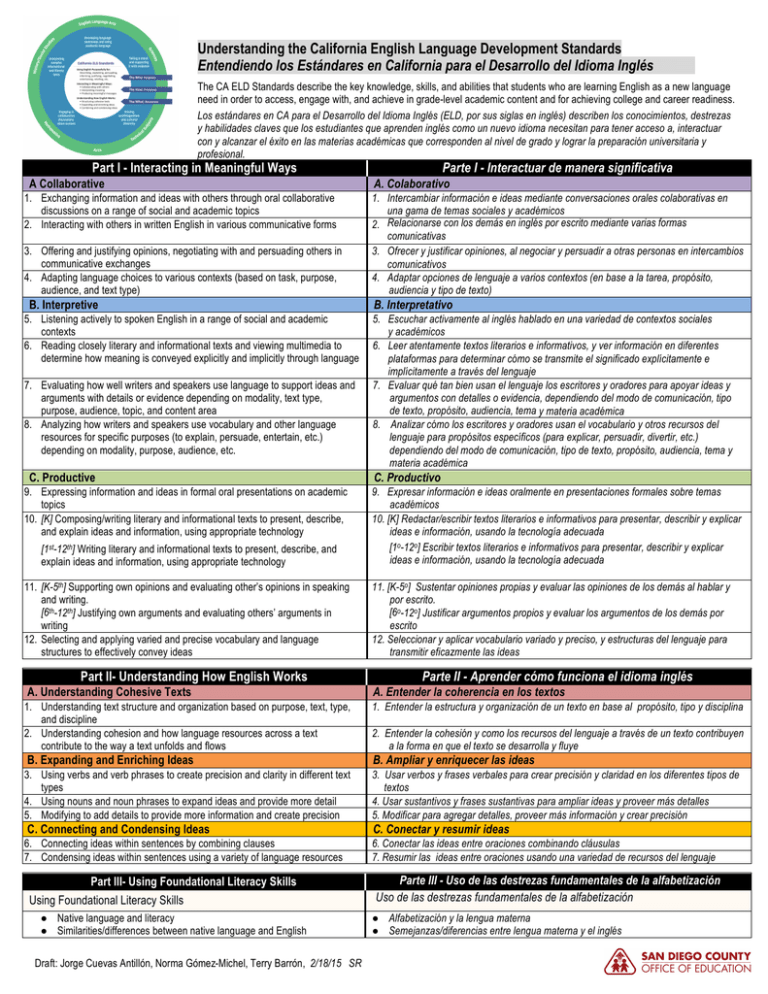
Understanding the California English Language Development Standards Entendiendo los Estándares en California para el Desarrollo del Idioma Inglés The CA ELD Standards describe the key knowledge, skills, and abilities that students who are learning English as a new language need in order to access, engage with, and achieve in grade-level academic content and for achieving college and career readiness. Los estándares en CA para el Desarrollo del Idioma Inglés (ELD, por sus siglas en inglés) describen los conocimientos, destrezas y habilidades claves que los estudiantes que aprenden inglés como un nuevo idioma necesitan para tener acceso a, interactuar con y alcanzar el éxito en las materias académicas que corresponden al nivel de grado y lograr la preparación universitaria y profesional. Parte I - Interactuar de manera significativa Part I - Interacting in Meaningful Ways A Collaborative 1. Exchanging information and ideas with others through oral collaborative discussions on a range of social and academic topics 2. Interacting with others in written English in various communicative forms 3. Offering and justifying opinions, negotiating with and persuading others in communicative exchanges 4. Adapting language choices to various contexts (based on task, purpose, audience, and text type) B. Interpretive 5. Listening actively to spoken English in a range of social and academic contexts 6. Reading closely literary and informational texts and viewing multimedia to determine how meaning is conveyed explicitly and implicitly through language 7. Evaluating how well writers and speakers use language to support ideas and arguments with details or evidence depending on modality, text type, purpose, audience, topic, and content area 8. Analyzing how writers and speakers use vocabulary and other language resources for specific purposes (to explain, persuade, entertain, etc.) depending on modality, purpose, audience, etc. C. Productive 9. Expressing information and ideas in formal oral presentations on academic topics 10. [K] Composing/writing literary and informational texts to present, describe, and explain ideas and information, using appropriate technology [1st-12th] Writing literary and informational texts to present, describe, and explain ideas and information, using appropriate technology 11. [K-5th] Supporting own opinions and evaluating other’s opinions in speaking and writing. [6th-12th] Justifying own arguments and evaluating others’ arguments in writing 12. Selecting and applying varied and precise vocabulary and language structures to effectively convey ideas Part II- Understanding How English Works A. Colaborativo 1. Intercambiar información e ideas mediante conversaciones orales colaborativas en una gama de temas sociales y académicos 2. Relacionarse con los demás en inglés por escrito mediante varias formas comunicativas 3. Ofrecer y justificar opiniones, al negociar y persuadir a otras personas en intercambios comunicativos 4. Adaptar opciones de lenguaje a varios contextos (en base a la tarea, propósito, audiencia y tipo de texto) B. Interpretativo 5. Escuchar activamente al inglés hablado en una variedad de contextos sociales y académicos 6. Leer atentamente textos literarios e informativos, y ver información en diferentes plataformas para determinar cómo se transmite el significado explícitamente e implícitamente a través del lenguaje 7. Evaluar qué tan bien usan el lenguaje los escritores y oradores para apoyar ideas y argumentos con detalles o evidencia, dependiendo del modo de comunicación, tipo de texto, propósito, audiencia, tema y materia académica 8. Analizar cómo los escritores y oradores usan el vocabulario y otros recursos del lenguaje para propósitos específicos (para explicar, persuadir, divertir, etc.) dependiendo del modo de comunicación, tipo de texto, propósito, audiencia, tema y materia académica C. Productivo 9. Expresar información e ideas oralmente en presentaciones formales sobre temas académicos 10. [K] Redactar/escribir textos literarios e informativos para presentar, describir y explicar ideas e información, usando la tecnología adecuada [1o-12o] Escribir textos literarios e informativos para presentar, describir y explicar ideas e información, usando la tecnología adecuada 11. [K-5o] Sustentar opiniones propias y evaluar las opiniones de los demás al hablar y por escrito. [6o-12o] Justificar argumentos propios y evaluar los argumentos de los demás por escrito 12. Seleccionar y aplicar vocabulario variado y preciso, y estructuras del lenguaje para transmitir eficazmente las ideas Parte II - Aprender cómo funciona el idioma inglés A. Understanding Cohesive Texts A. Entender la coherencia en los textos 1. Understanding text structure and organization based on purpose, text, type, and discipline 2. Understanding cohesion and how language resources across a text contribute to the way a text unfolds and flows 1. Entender la estructura y organización de un texto en base al propósito, tipo y disciplina 2. Entender la cohesión y como los recursos del lenguaje a través de un texto contribuyen a la forma en que el texto se desarrolla y fluye B. Expanding and Enriching Ideas B. Ampliar y enriquecer las ideas 3. Using verbs and verb phrases to create precision and clarity in different text types 4. Using nouns and noun phrases to expand ideas and provide more detail 5. Modifying to add details to provide more information and create precision 3. Usar verbos y frases verbales para crear precisión y claridad en los diferentes tipos de textos 4. Usar sustantivos y frases sustantivas para ampliar ideas y proveer más detalles 5. Modificar para agregar detalles, proveer más información y crear precisión C. Connecting and Condensing Ideas 6. Connecting ideas within sentences by combining clauses 7. Condensing ideas within sentences using a variety of language resources Part III- Using Foundational Literacy Skills Using Foundational Literacy Skills ● Native language and literacy ● Similarities/differences between native language and English Draft: Jorge Cuevas Antillón, Norma Gómez-Michel, Terry Barrón, 2/18/15 SR C. Conectar y resumir ideas 6. Conectar las ideas entre oraciones combinando cláusulas 7. Resumir las ideas entre oraciones usando una variedad de recursos del lenguaje Parte III - Uso de las destrezas fundamentales de la alfabetización Uso de las destrezas fundamentales de la alfabetización ● Alfabetización y la lengua materna ● Semejanzas/diferencias entre lengua materna y el inglés
